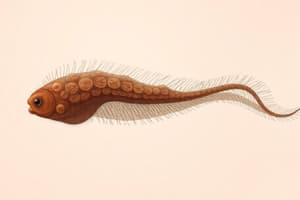Podcast
Questions and Answers
What clinical symptom might develop if flukes block the bile ducts?
What clinical symptom might develop if flukes block the bile ducts?
- Neuropathic pain
- Obstructive jaundice (correct)
- Pulmonary edema
- Hypertension
What is one of the methods used to diagnose fasciolosis?
What is one of the methods used to diagnose fasciolosis?
- Demonstration of eggs in stool (correct)
- Blood culture
- CT scan of the liver
- Ultrasound examination
What step is recommended to confirm or reject a suspected diagnosis of fasciolosis?
What step is recommended to confirm or reject a suspected diagnosis of fasciolosis?
- Stop eating raw liver for a week (correct)
- Increase water intake
- Stop consuming alcohol for a week
- Start a high-fiber diet
Which organism serves as the definitive host for Clonorchis sinensis?
Which organism serves as the definitive host for Clonorchis sinensis?
What is one of the geographic regions where Clonorchis sinensis is endemic?
What is one of the geographic regions where Clonorchis sinensis is endemic?
Flashcards
Clonorchosis
Clonorchosis
The Chinese liver fluke, Clonorchis sinensis, causes clonorchosis. This parasitic infection is endemic and anthropozoonotic, meaning it is common in specific areas and can be transmitted between animals and humans.
Clonorchis sinensis Morphology
Clonorchis sinensis Morphology
The adult fluke is about 1 cm long and narrower than Fasciola hepatica. It has an operculated egg, measuring 25-30 micrometers.
Clonorchis sinensis Definitive Hosts
Clonorchis sinensis Definitive Hosts
Humans are the definitive host for Clonorchis sinensis, but it also infects dogs, cats, pigs, and other mammals. This makes control challenging due to the numerous reservoir hosts.
Clonorchis sinensis Intermediate Hosts
Clonorchis sinensis Intermediate Hosts
Signup and view all the flashcards
Clonorchis sinensis Life Cycle
Clonorchis sinensis Life Cycle
Signup and view all the flashcards
Study Notes
Fasciola hepatica
- Pathogenicity: Causes various symptoms including nausea, vomiting, fever, pain, allergic reactions, diarrhea, hepatomegaly (enlarged liver), and eosinophilia.
- Complications: Blockage of bile ducts can lead to obstructive jaundice. Severe cases can result in liver cirrhosis (scarring) and hepatic failure. Chronic infection involves liver inflammation with abscess formation (liver rot).
- Diagnosis: Detection of eggs in stool or bile (obtained via duodenal intubation). A follow-up stool examination after a week of avoiding raw liver can help confirm or rule out fasciolosis.
- Prevention: Avoiding raw/unwashed vegetables, fruits, and contaminated water. Eradication in animal reservoirs, and draining fields to eliminate snail hosts are key preventive measures.
Clonorchis sinensis
- Disease: Causes clonorchosis, an endemic and anthropozoonotic parasitic infection.
- Geographic Distribution: Primarily found in China and Japan.
- Habitat: Infects bile ducts.
- Morphology: Adult worms are approximately 1 cm long and narrower than Fasciola hepatica. Eggs are operculated (lidded) and measure 25-30 micrometers.
- Life Cycle:
- Definitive host is humans, but also affects dogs, cats, pigs and other mammals.
- First intermediate host: freshwater snails.
- Second intermediate host: freshwater fish.
- Adult flukes release eggs into the intestines via bile ducts, then eggs are passed in stool.
Paragonimus westermani
- (No details provided in the supplied text)
Studying That Suits You
Use AI to generate personalized quizzes and flashcards to suit your learning preferences.




